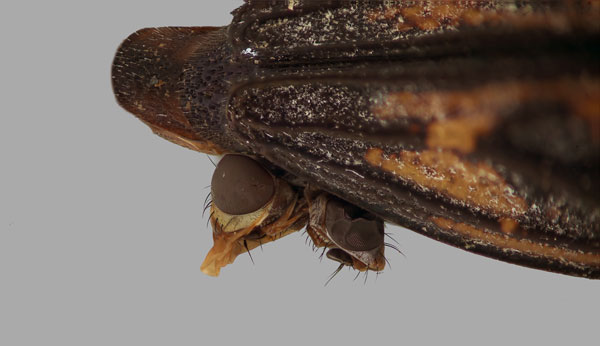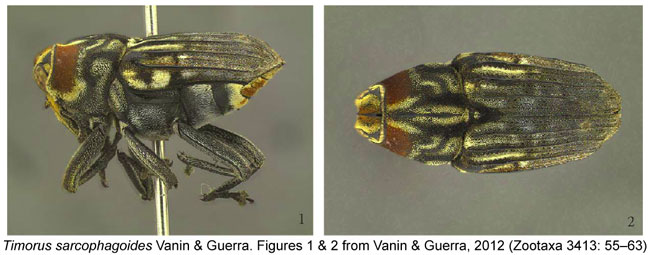What makes a good mystery? Well, usually a death is involved, there’s an unexpected plot twist along the way, and undoubtedly a shadowy figure no one expects ends up playing a central role. Toss in a few scorpions, a handful of maggots, and a dead body and you’re well on your way to a New York Times bestseller! But perhaps I’m getting ahead of myself, s0 allow me to set the scene.
The Chinese scorpion, Mesobuthus martensii, is a species of medical interest, not just because it has a stinger and can inflict injury on others, but because the chemicals of its sting are being explored for our use in medicine. Peptides produced in the stinger have been used as antimicrobial agents, have been shown to reduce convulsions in epileptic rats and cancerous tumours in human cell cultures. However, because of its newfound value to medicine (and a long-standing role in Chinese traditional medicine), wild populations of the Chinese scorpion are declining across their native range (from Mongolia to North Korea and Japan), and the species is now considered vulnerable by Chinese conservation biologists. Needless to say, this is one scorpion species whose natural history would be good to understand, and yet one we know very little about.
Working from a brief and poorly recorded observation of fly larvae hanging around a dead scorpion, a team of researchers lead by Cheng-Min Shi set out to understand the natural enemies and parasitoids of the Chinese scorpion and started by combing Niushou Mountain for scorpions, collecting a few hundred scorpions in the process. They then brought the live scorpions back to the lab and waited and watched to see what would happen. What they found however, raised many more questions: questions that extend far beyond the mountains of Northeastern China.
Of the 317 specimens they brought back to the lab, 73 died within the first nine days, the majority of which soon spawned dozens of wriggling, late-instar maggots. After rearing many of these maggots to adulthood, and sequencing the DNA of both adults and larvae, the researchers were able to put a name on the first recorded parasitoid for this important scorpion species: Sarcophaga (Liosarcophaga) dux, a species of flesh fly in the family Sarcophagidae. Parasitoid flesh flies aren’t that unusual; flesh flies have been recorded in a wide variety of hosts, from grasshoppers and millipedes to crabs, and even frogs. And flies parasitizing scorpions isn’t even that unique; there are tachinid flies that are known parasitoids of other scorpion species. But what is unusual is that we had already found the larvae of Sarcophaga dux before, and they didn’t come out of a scorpion.
It turns out that Sarcophaga dux is actually a relatively common species of flesh fly, known from across Asia and Europe, with a range stretching all the way from Japan to France. The species has even managed to spread throughout the South Pacific, reaching as far away as Australia and Hawaii. Until now we had thought it to have been closely associated with humans, following us around the world and feeding upon our waste, among other things: an adult fly was once captured on a dead body in Switzerland and studied for forensic purposes, while a few maggots were removed from the ear of a newborn baby in Thailand, which, it bears pointing out, is definitely not the same thing as a scorpion. So now we have a species that in some places is a parasitoid, in other places a saprophage (feeding on microbes and fecal matter), but also a sarcophage when the opportunity arises (feeding on dead stuff that it didn’t kill itself). Oh, and it can cause myiasis and survive by eating living tissue, like in that baby’s ear, or in cattle. It’s not uncommon to see a range of species in a genus exhibit each of these different life styles, or even for species to evolve from one life style to another as they shift from generalists to specialists (or vice versa). The Sarcophagidae in particular have evolved parasitic and parasitoidism many times independently, but an all-in-one package like this? That’s unheard of.
How can a species display a life history that ranges from the incredibly specialized role of scorpion parasitoid to a jack-of-all-trades at home in the big, bright world of garbage, dead bodies, and ear canals? By all accounts a parasitoid without its host should die, and a generalist omnivore should not be able to outsmart the immune system of a scorpion. Welcome to the mystery of the unexplainable life history.

Can you tell which Sarcophaga dux specimen comes from where based on the male genitalia? Left, from Thailand (assumably collected with carrion bait)(Sukontason et al., 2014); Centre, from Thailand, aural myiasis in child (Chaiwong et al., 2014); Right, from China, reared from scorpion (Shi et al., 2015). Click to enlarge and take a closer look.
Clearly something is going on here, and it’s going to take some very careful sleuthing to figure out what Sarcophaga dux really is. By looking at the genitalia of male flies, the tool that cracks the case for most fly taxonomists, you’d be hard pressed to tell which specimens had been raised inside a scorpion and which came from free-ranging maggots. But when Shi and colleagues looked closer at the DNA, they found that the flies they reared from scorpions differed from the rest of the Sarcophaga dux specimens by a consistent 1.25%. And while a genetic difference of 1.25% may seem insignificant, it represents the first clue that Sarcophaga dux may be more than just a single species with a confoundingly diverse life history.
And that’s the best thing about studying natural history and taxonomy. Unlike a mystery novel that’s wrapped up with a nice, pretty bow by the final page, when we begin unravelling one taxonomic mystery, we invariably stumble upon a new wave of unknowns just waiting for our curiosity to be piqued.
—
Main paper:
Shi, C.-M., Zhang, X.-S. & Zhang, D.-X. (2015) Parasitoidism of the Sarcophaga dux (Diptera: Sarcophagidae) on the Mesobuthus martensii (Scorpiones: Buthidae) and Its Implications. Annals of the Entomological Society of America. http://dx.doi.org/10.1093/aesa/sav090
Supplementary papers:
Chaiwong, T., Tem-Eiam, N., Limpavithayakul, M., Boongunha, N., Poolphol, W. & Sukontason, K.L. (2014) Aural myiasis caused by Parasarcophaga (Liosarcophaga) dux (Thomson) in Thailand. Tropical biomedicine 31, 496–8.
Sukontason, K.L., Sanit, S., Klong-Klaew, T., Tomberlin, J.K. & Sukontason, K. (2014) Sarcophaga (Liosarcophaga) dux (Diptera: Sarcophagidae): A flesh fly species of medical importance. Biological research 47, 14.



